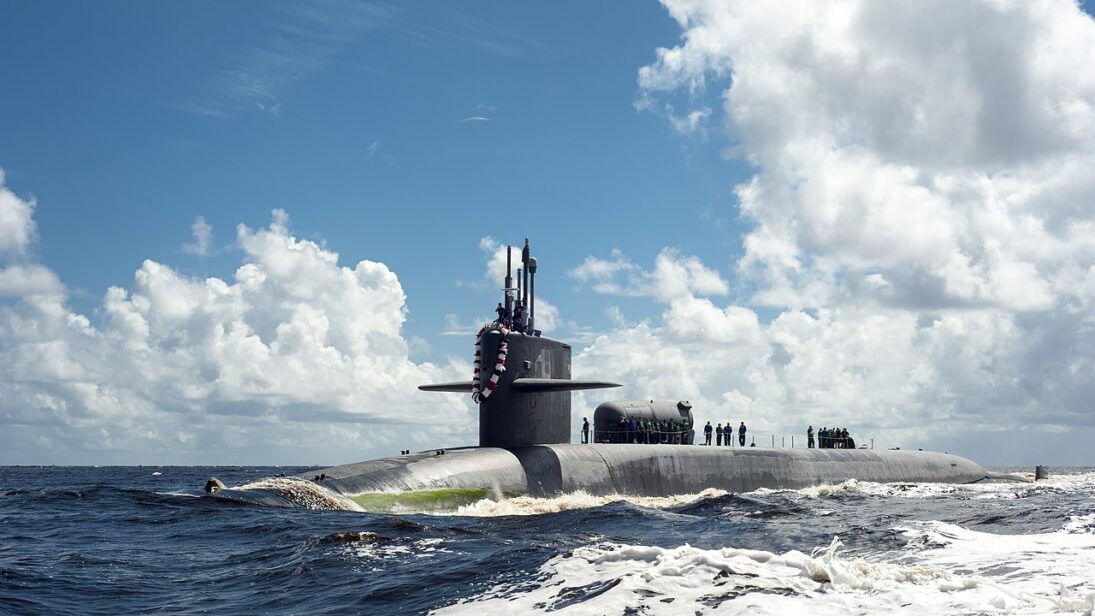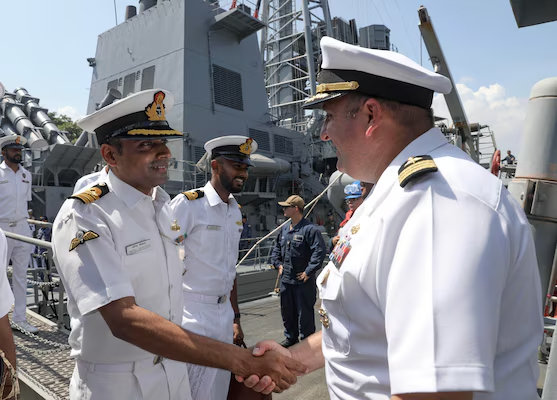 To celebrate the release of Naval Competition in the Indian Ocean Region, a new online course from the Stimson Center South Asia program’s Strategic Learning initiative, the South Asian Voices (SAV) editorial team collaborated with the Strategic Learning team on a wide-ranging SAV Q&A that explores the importance of naval competition in the region, recent and ongoing developments in the naval domain, and opportunities for future cooperation. We interviewed experts Nilanthi Samaranayake (Visiting Expert at the United States Institute of Peace), Tanzeela Khalil (Research Fellow at the Islamabad Policy Research Institute), and Viraj Solanki (Research Fellow at the International Institute for Strategic Studies).
To celebrate the release of Naval Competition in the Indian Ocean Region, a new online course from the Stimson Center South Asia program’s Strategic Learning initiative, the South Asian Voices (SAV) editorial team collaborated with the Strategic Learning team on a wide-ranging SAV Q&A that explores the importance of naval competition in the region, recent and ongoing developments in the naval domain, and opportunities for future cooperation. We interviewed experts Nilanthi Samaranayake (Visiting Expert at the United States Institute of Peace), Tanzeela Khalil (Research Fellow at the Islamabad Policy Research Institute), and Viraj Solanki (Research Fellow at the International Institute for Strategic Studies).
This SAV Q&A has been edited for length and clarity.
I: Importance of Naval Competition
Tanzeela and Viraj, we’ll start with you: In your respective views, what makes the naval domain important for understanding strategic competition in the Indian Ocean Region?
Tanzeela Khalil: The naval domain not only offers extended reach for military power projection but also serves as an integral part of securing economic interests. In the Indian Ocean Region (IOR), the naval domain is intertwined with economic, geopolitical, and regional security factors.
The IOR hosts vital sea lines of communication and approximately 80% of the global oil trade. The efforts of major powers to project their respective power in the form of strong naval presences has raised security concerns of the smaller regional countries and adds an additional layer of complexity.
Given the trade activity that makes the region extremely congested, increasing naval activities, and involvement of multiple nuclear weapon states and their sea-based nuclear forces, the risk of crisis escalation cannot be ignored.
Viraj Solanki: The naval and maritime domain has become increasingly important for understanding strategic competition in the IOR in the last few years. Island and littoral states in the region are expanding their military modernization efforts and defense cooperation with external and regional partners as major power rivalries increasingly play out on their shores.
Strategically significant due to their proximity to major international sea lanes, the island and littoral nations in the Indian Ocean are witnessing a significant increase in major power interest, including the U.S.-China and India-China rivalries, driven primarily by security concerns and geo-economic interests.
Tanzeela Khalil: “The IOR hosts vital sea lines of communication and approximately 80% of the global oil trade. The efforts of major powers to project their respective power in the form of strong naval presences has raised security concerns of the smaller regional countries and adds an additional layer of complexity.”
II. Current Trends and Future Developments
Tanzeela, there have been several new developments in the Pakistan Navy in 2024, including the launch of the first of eight submarines being procured from China, commissioning of a corvette and patrol vessel, and the recent test of a ship-launched ballistic missile. What are the primary objectives of the Pakistan Navy, and how might recent or ongoing procurements help it meet those objectives?
TK: The primary objectives of the Pakistan Navy include protecting maritime interests, deterring aggression at and from sea, providing disaster relief, and contributing to international efforts of maintaining order at sea. The Pakistan Navy is conscious of regional developments and is focused on modernizing its naval forces to transition towards an effective and sustainable force, ensure combat readiness, and respond swiftly to any aggression.
The Pakistan Navy envisions expanding its surface fleet to 50 ships, including 20 major surface vessels. The recent acquisitions by the Pakistan Navy will be a critical step in fulfilling the requirements of conventional deterrence to cater to the evolving regional threat environment in the maritime domain, specifically with regard to an increasing Indian role in the IOR. The recent commissioning of India’s second nuclear-powered ballistic missile submarine INS Arighaat and ongoing projects indicate that India would be operating six nuclear-powered submarines in the coming years. This is likely to be seen as a destabilizing development by Pakistan and warrants corrective measures to ensure deterrence stability.
Nilanthi, as you observed in a recent article, there is “only a single substantive mention of the Indian Ocean in each of the three high-level U.S. strategy documents released in 2022.” What challenges does this lack of strategic guidance create for the United States and its allies? What are the most important questions a U.S. strategy for the Indian Ocean should answer?
NS: A challenge of this strategic inattention is that the Indian Ocean is a kind of Rorschach test, with U.S. priorities within the region often depending on the eye of the beholder and their positionality. Multiple bureaus and combatant commands currently have responsibility for different segments of the Indian Ocean Region, giving rise to different priorities for U.S. national interests.
Key questions for an Indian Ocean strategy include: a) What are U.S. objectives in the Indian Ocean? and b) What assumptions underpin these objectives? Policymakers should consider how U.S. objectives in this region compare with those in other maritime regions, given the United States’ global interests and requirements. Not all information needs to be publicly released, but policymakers should foremost be clear among themselves about the answers to these questions before they develop plans to implement U.S. objectives in the region.
Considering this U.S. “strategic inattention” on the region, Viraj, what are the potential implications of naval competition in the Indian Ocean for the region’s island and littoral states?
VS: As major powers compete for influence, and the room for maneuvering tightens, smaller nations are seeking the autonomy to set the agenda. In response, island and littoral states have adapted their domestic and foreign policy agendas to pursue their own priorities, such as boosting maritime domain awareness (MDA) and engaging on disaster management issues.
Disaster prevention and management is one means by which island and littoral states can frame their non-traditional concerns – such as the impact of climate change, natural disasters, or pollution – in a manner consistent with the interests of larger powers, especially the US–China and China–India rivalries.
But for major powers, traditional security concerns take precedence over the non-traditional interests of most island and littoral states. This reduces regional states’ ability to balance their defense cooperation and wider engagement with a larger power on their preferred terms.

Tanzeela, how will emerging technologies impact the future of security and stability in the naval domain in the Indian Ocean Region?
TK: Integration of emerging technologies like artificial intelligence (AI), cyber, and quantum in the military domain will have a profound impact on the future of warfare. Emerging technologies like AI and quantum computing could improve situational awareness, enable fast strategic decision-making in complex situations, enhance detection capabilities through quantum sensors and radars, overcome GPS vulnerabilities, offer secure communication channels, and allow precise navigation.
However, the same technologies could be employed to undermine the survivability of the adversary’s second-strike capability. Moreover, faster decision-making could be problematic in this region, given the already short reaction times and the propensity of crises occurring in a politically charged environment.
III. Looking Ahead
Nilanthi, what role, if any, can the United States play in ensuring stability at sea among the three Southern Asian nuclear powers?
NS: India, Pakistan, and China have their own complex relations to manage with each other. Against this backdrop and the wider set of regional dynamics, the United States contributes to stability at sea by emphasizing the right of all countries to operate according to international law in Indian Ocean sea lanes.
A U.S. objective for more than four decades has been to uphold the free flow of commerce and, more broadly, peaceful norms in the region. The ongoing Operation Prosperity Guardian is being conducted in response to attacks on commercial shipping by Houthis in Yemen and is a high-profile example of the priority of this issue for Washington. The U.S. commitment to international law and safe operations at sea helps bolster stability in the IOR.
Viraj Solanki: “As major powers compete for influence, and the room for maneuvering tightens, smaller nations are seeking the autonomy to set the agenda.”
As we conclude, Nilanthi and Tanzeela, what ongoing trends or potential flashpoints in the Indian Ocean Region pose the greatest risks to security and stability at sea over the next five years?
NS: There are two top potential risks to highlight in the IOR. Firstly, while China receives increasing attention in the Indian Ocean, the long-standing India-Pakistan conflict has the potential to inflict the greatest harm, with miscalculations or accidents at sea involving both countries’ nuclear capabilities and submarines.
Secondly, gray-zone activity also poses a risk to Indian Ocean security. For example, in 2018, China used lasers against U.S. Air Force personnel operating in Djibouti, which could have been fatal. Washington protested this action, and China appears not to have repeated it since. The potential for China to pursue additional incidents of gray-zone activity in the Indian Ocean should be closely monitored.
TK: The formation of minilateral alliances in the form of the Quad (United States, Japan, Australia, and India), AUKUS (Australia, United States, and United Kingdom) and a potential INFRUS (India, France, and the United States) to ensure the so-called “Free and Open Indo-Pacific,” pose serious risks to the security and stability of the IOR. India being the constant factor in most of these arrangements, backed by the political and military support of the West through strategic partnerships aimed at countering China, is detrimental to the South Asian strategic balance.
As part of its rebalancing strategy to contain China, the United States is hyphenating the Indian and Pacific Oceans and is ready to franchise its near monopoly in the Indian Ocean to India and make it the net security provider in the region. However, several Indian developments, in the pretext of containing China, also threaten Pakistan’s security interests.
With those potential flashpoints in mind, Viraj, what issue areas hold the most promise for future cooperation among states in the Indian Ocean Region?
VS: Enhancing regional cooperation MDA has a lot of promise for future cooperation among states in the Indian Ocean Region. Many of India’s maritime exercises and activities are focusing on enhancing MDA. New Delhi has also provided coastal radar surveillance systems to the island nations to enhance joint surveillance of their exclusive economic zones (EEZ), with India thereby also gaining a better awareness of maritime activities in its neighborhood. An increasingly important platform for regional cooperation is the Colombo Security Conclave. Anchored by India, this is the most active security-focused group in the IOR. The Conclave brings together government officials up to the level of national security adviser from the Maldives, Mauritius, and Sri Lanka. Bangladesh agreed to join as a member in July 2024, with Seychelles as an observer. Its remit includes maritime security, cyber security, and countering terrorism, and there is practical cooperation through security-focused exercises. Significantly, in August 2024, participating countries formalized a charter and a memorandum of understanding to create an organizational secretariat based in Sri Lanka.
source : southasianvoices
